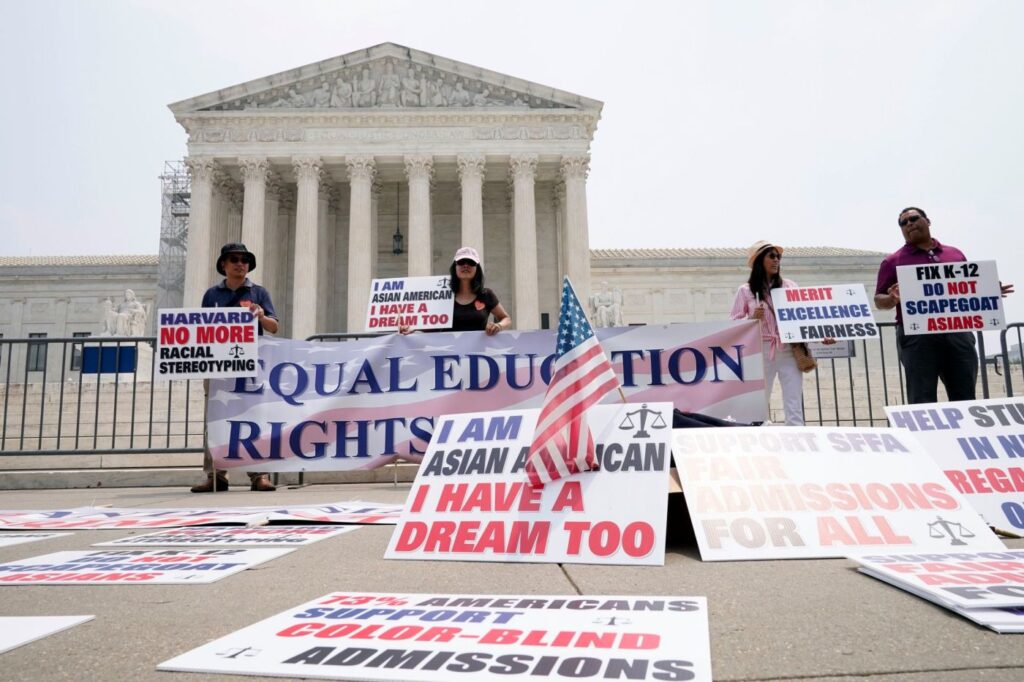
On Thursday, the U.S. Supreme Court explicitly reaffirmed the principle that the Constitution is colorblind, using that very phrase. The guarantee that no person will be denied the equal protection of the laws applies to all, no matter the person’s race.
Before the decision in Students for Fair Admissions, the 14th Amendment’s requirement that government not favor one race over another had three court-made exceptions: 1) to remedy a specific wrong imposed on an individual because of that individual’s race (like ordering the rehiring of a government employee who had been discriminatorily fired); 2) to prevent imminent physical harm (as in separating prisoners by race during a race-riot in a prison); and 3) to achieve racial diversity in higher education for its supposed educational benefits.
The third category ended last Thursday. It was weak from the start. In 1978, when it was first recognized by a single Justice in the Bakke decision (though later accepted by a majority of five justices in 2003), achieving educational benefits of racial diversity was more amorphous than the other two permissible uses of race by government.
An exception to the 14th Amendment’s colorblind principle had to be compelling, the Court ruled, and diversity’s benefits in higher education failed that test. Much more had to be shown than simply that a program would benefit a racial group.
The University of North Carolina argued that diversity helped all students who were admitted. However, racial preferences denied benefits to those not admitted, who would have been admitted were they of a different race. Those students were denied the equal protection of the law by a public university, bound by the 14th Amendment.
The Court also put an end to the sophistry that the government could make use of race a little bit, so long as it was not a deciding factor. The Court analogized that to the discredited defense of Jim Crow: that separate facilities were permissible so long as they were equal. No—when government treats people differently because of their race, it is inherently unequal: whether through using race as a “plus factor” or a quota.
The dissenting Justices, sensing the weakness of the “diversity” defense, put forward a different rationale: that government could favor members of one race in order to remedy “societal discrimination.” The majority responded that purpose had never been held sufficient to justify unequal treatment by government, from the Bakke case through all subsequent affirmative action cases.
Hence, the predictable cries from the left that the Students for Fair Admissions decision was further evidence of a hostile conservative court are misplaced. We’ve had liberal and conservative majorities at different times on the Supreme Court over the last half century; none has embraced a generic goal of remedying societal discrimination as an adequate basis for undoing the simple and profound requirement of the 14th Amendment that government treat individuals equally, without regard to their race.
Related Articles
Judge Andrew Napolitano: Can the president fight any war he wishes?
Veronique de Rugy: America needs a president who will actually take spending seriously
Charter schools excel while traditional, union-dominated schools rot
States gain from letting immigrants work
Anaheim voters should reject $25 wage edict
Claims to uphold government actions that violate the Constitution are always offered in service of a higher good. No doubt we would have less crime if police did not have to obtain warrants but could search persons and places at their whim. Constitutions exist to constrain government, not to be ignored in pursuit of goals that seem popular.
In 1988, Justice O’Connor particularly cautioned against the influence of racial politics when government creates preference programs. Dividing Americans by race and offering benefits to some can be a path to electoral success, she said, but it is nonetheless unconstitutional, and, fundamentally, corrosive.
The most recent California example is ACA 5, allowing the state to implement programs that would lead to improved “life expectancy,” “educational outcomes,” or “lifting out of poverty specific groups based on race . . . .”
Why not improve those things for all Californians, regardless of their race?
Thursday’s decision points California in that direction, instead of more racial division.
Tom Campbell is a professor of law and a professor of economics at Chapman University. He clerked for Justice Byron R. White of the US Supreme Court the year Bakke, the first affirmative action case, was decided. He has been a tenured faculty member at both Stanford Law School and at Chapman, teaching courses in constitutional separation of powers. He was a US Congressman for five terms, and a California State Senator, resigning from the Republican party in 2016.
